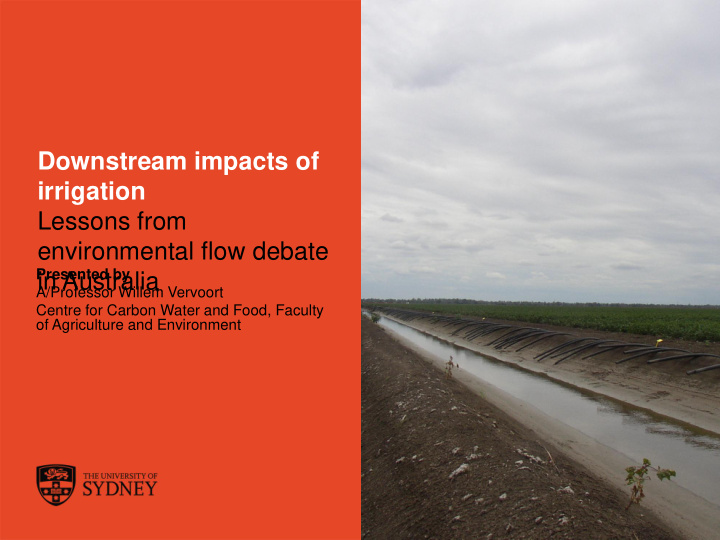



Downstream impacts of irrigation Lessons from environmental flow debate Presented by in Australia A/Professor Willem Vervoort Centre for Carbon Water and Food, Faculty of Agriculture and Environment The University of Sydney Page 1
Irrigation diversion in the Murray Darling Basin • The Murray Darling Basin is Australia’s main agricultural production area and largest river basin (1 mln km 2 ) • Agriculture (Irrigation) uses 70% of the water • This has severely affected volumes of flows Natural average outflow to the ocean 14000 NSW • 1993/94 limit on 12000 VIC licences for extraction: 10000 GL/year the CAP SA 8000 • Since then efforts to Qld 6000 reduce the CAP ACT 4000 • Water use Total 2000 efficiency CAP 0 • Licence buy back 1993/94 1920 1970 2020 Year The University of Sydney Page 2
CSIRO sustainable yields project and MDB plan 2012 http://www.csiro.au/en/Research/LWF/Area s/Water-resources/Assessing-water- resources/Sustainable- yields/MurrayDarlingBasin – Additional water needed to sustain environment (wetlands and water dependent ecosystems). – Plan aims at returning 2700 GL/yr, but buyback capped at 1500 GL/yr – Increased role of “water markets”: – https://www.waterexchange.com.au/cgi- bin/zonetrade/TradingPlatform/Markets – Agreement between state and commonwealth to “vary” the amount returned to the environment depending on climate The University of Sydney Page 3
The University of Sydney Page 4
How does irrigation extraction and irrigation development affect downstream rivers (locally and globally) – Reduction in flow. – Q = Input – ET (long term equilibrium) – Any change in ET will decrease Q: shifting blue water (Q) to green water (ET) – Flow inversion, timing mismatch between natural high flows and irrigation demands – Irrigation demand in summer, flows from Dam – Natural high flow in winter, stored in Dam – Salinity, salt balance – Salt storage = Salt Input – Salt Output. – To manage salt storage, salt output needs to increase if input increases with irrigation water: Leaching Fraction – Other water quality issues: – Blue Green Algae due to low flows – Acid sulphate soil exposure The University of Sydney Page 5
Flow impacts of regulation Increase in low flows Decrease in high flows Impact greater in drought The University of Sydney Page 6
What future effects might be a problem – Currently a major push to protect – RAMSAR wetland sites – Lower lakes (exit point of system) – Climate change predictions for Australia: – Increasing and worsening drought – More intense rainfall – Storage problem will increase, demand for irrigated agriculture will increase, pressure on ecosystems will increase – How do we deal with data scarcity and data uncertainty?: – Gauge measurements up to 20% uncertainty – Low density of gauging stations on 1 mln km 2 – Semi-arid, anastomising, highly variable rivers – We work at very large scales! The University of Sydney Page 7
Australian Hydrology Image from Google Earth Mean 3681.3 Median 79.0 Stdev 15159.7 A typical Australian inland river CV 4.1 Daily flows in ML/day Average 96 days of no flow/year The University of Sydney Page 8
Current MDB Environmental Water http://www.mdba.gov.au/what-we-do/environmental-water – Focuses on improving the resilience of the rivers, wetlands and floodplains and plants and animals related with it. – Driven by “Environmental Watering plan”, which is based on Adaptive management – Overall environmental objectives (Water Act 2007); – Targets for measuring progress (Part of the Basin Plan), watering of selected wetland sites, based on expert panels; – Monitoring, evaluation and reporting (so progress can be measured and evaluated scientifically); and – Learning by doing. The University of Sydney Page 9
What are the great unknowns? – Thresholds for dependent vegetation: – How much water can be shared with humans? – What are ecological thresholds across 1 mln km 2 – Understanding groundwater and water uptake of groundwater dependent trees (Vervoort & van der Zee, 2012; Holland et al.) – Better understanding of flow variability and drought – Seasonal Forecasting (Montazerolghaem et al. 2015) and climate change (see the excellent BOM website: www.bom.gov.au) – Connectivity and impact of irrigation – Managing palaeochannels and deep drainage (e.g. Bennett et al. 2013; Vanags & Vervoort, 2014) – Long term salinity and sodicity (e.g. Shah et al. 2014) – Water use efficiency impacts – Impacts of water trading, especially space-time The University of Sydney Page 10
Deep drainage Water uptake by Risk vegetation Deep drainage risk varies in space Water uptake from connected Depends on uncertainty in input groundwater is a function of variables distance of the stream The University of Sydney Page 11
The use of new data – Satellite data to better understand water balance of a catchment – Soil Moisture and ET data for model calibration to improve water resource planning – Increase model certainty The University of Sydney Page 12
Conclusions – Irrigation and irrigation development will always impact downstream ecosystems and other users – Changes in flow timing, quantity and distribution – Salinity impacts are also unavoidable, simple salt balance – Exacerbated in a high salt environment – Large spaces and low data density makes assessment of impacts difficult – New data and new tools might improve assessing impact – Identification of thresholds is crucial and needs to be more than location or species specific – Impact of climate change? The University of Sydney Page 13
Recommend
More recommend